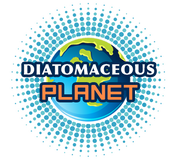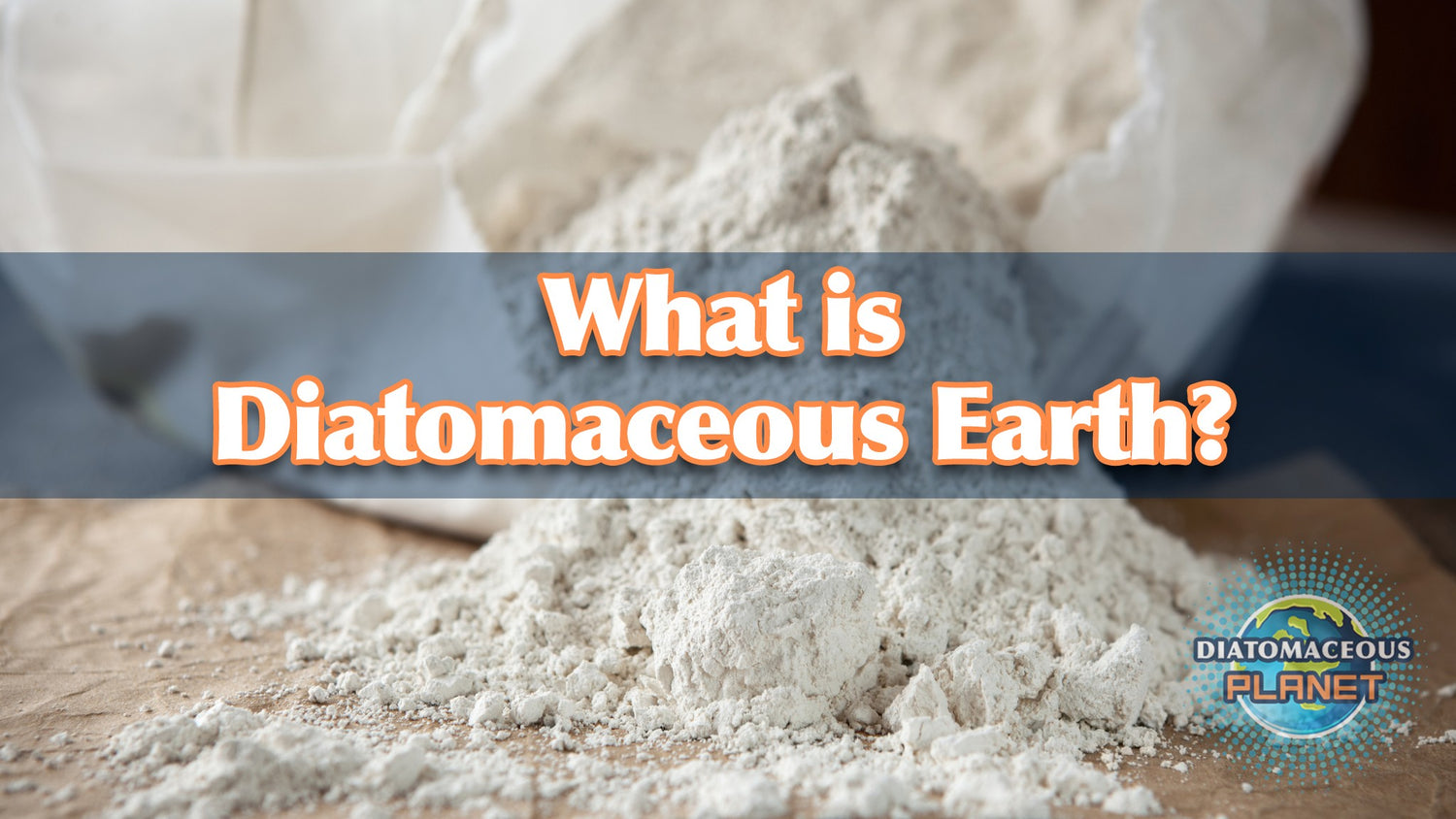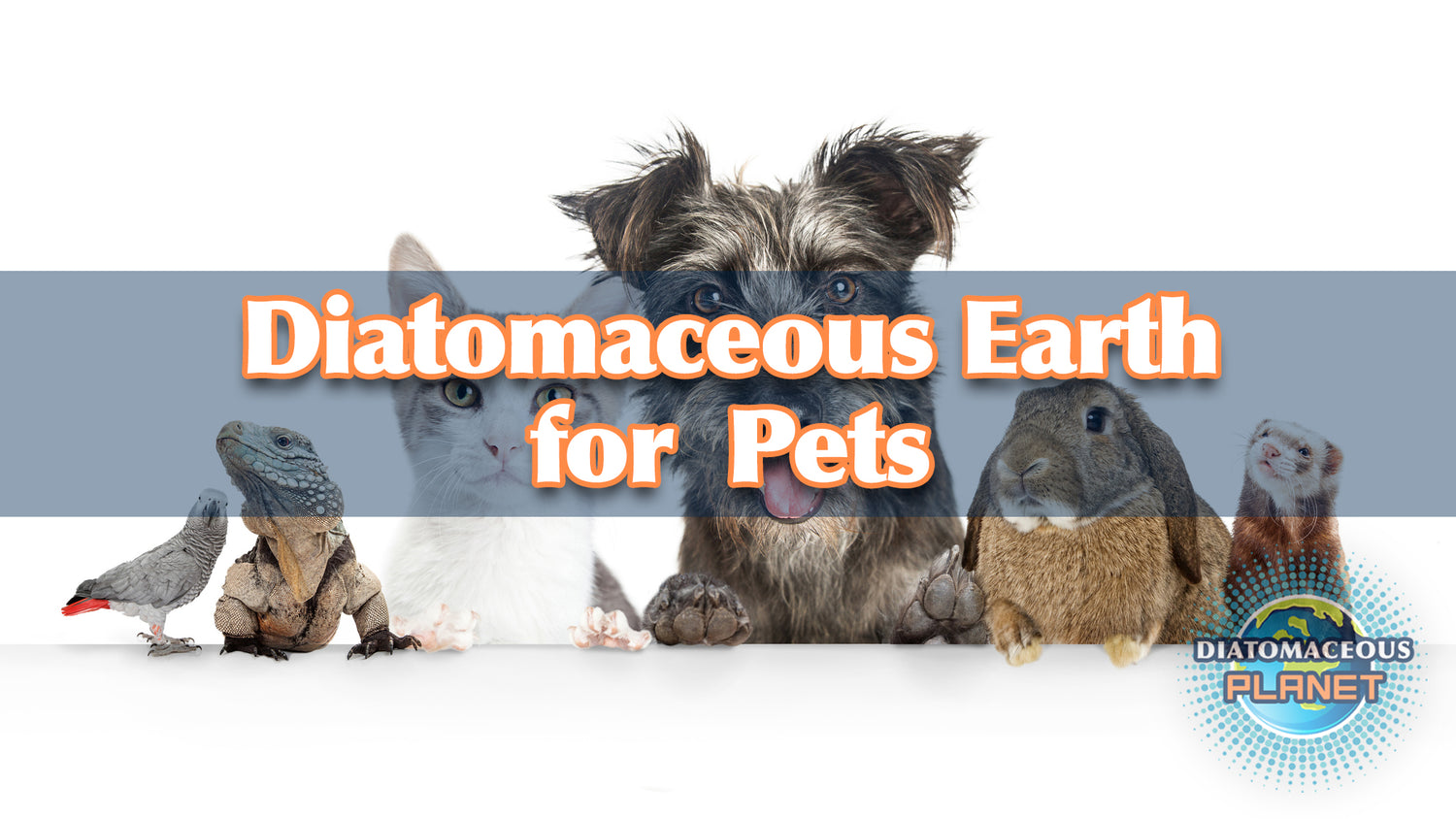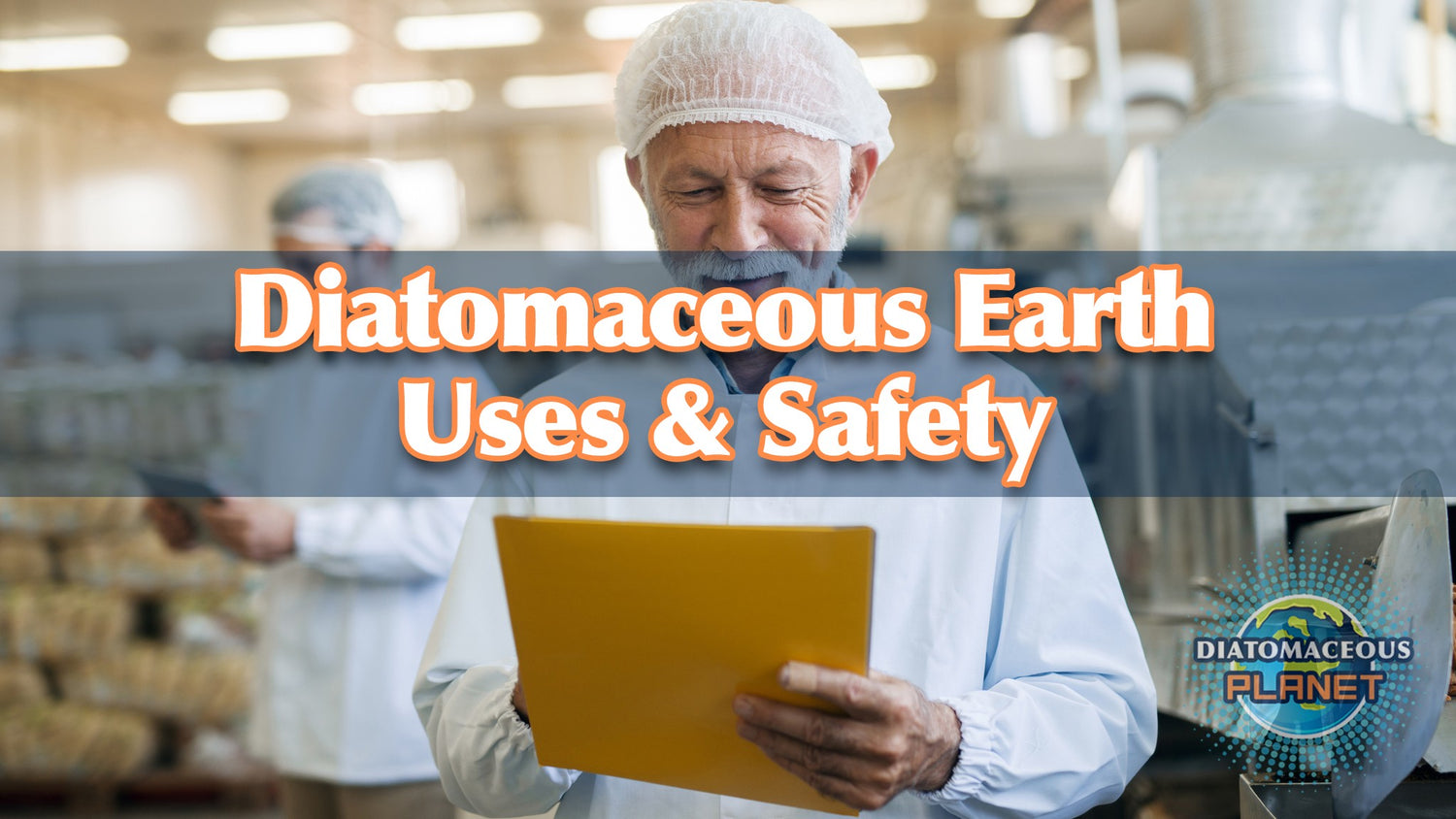Welcome to Diatomaceous Planet!
Diatomaceous earth (DE) is a naturally occurring, soft, sedimentary rock formed from the fossilized remains of diatoms, a type of microscopic algae. After the diatomite (raw DE) is collected, crushed, and refined; the final product is a silky, soft, off-white powder. There are many grades and forms of DE, depending on the intended use.
Food Grade Diatomaceous Earth (Food Grade DE) is the most commonly used kind of diatomite. Food Grade DE is uncalcined, which means it is a natural product; not altered or changed by heat or pressure treatments.
After the DE is purified and tested to meet food processing standards, it is then ready to be used as natural ingredient in a wide variety of food, beverage, personal, and even pet products!

Why Choose Diatomaceous Planet's Food Grade D-Earth?
We've got the following DE fact list here for you to make an educated decision:
- 100% Pure Food Grade Diatomaceous Earth.
- Mined from freshwater diatomite sources.
- Uncalcined (unmodified) with NO ADDITIVES.
- Highest levels of (amorphous) natural silica at 89-91%.
- Lowest levels of crystalline silica (<0.001 or less than 0.01%).
- Safe for Pets and People (our product is pure "Food Grade DE").
- Ideal for Homesteads, Gardens, DIY, and Artisan projects/products.
Diatomaceous Earth available in Canada:
If you are shopping for top quality Food Grade Diatomaceous Earth in Canada, we have many product sizes in-stock and ready to ship... We currently offer FREE Expedited, Canada-wide shipping on all orders. Please take a look at our available options when you're ready to order Food Grade Diatomaceous Earth.
-
Food Grade Diatomaceous Earth 1kg/2.2 lbs
Vendor:diatomaceousplanetRegular price $21.49 CADRegular priceUnit price per$22.99 CADSale price $21.49 CADSale -
Food Grade Diatomaceous Earth 2kg/4.4 lbs
Vendor:diatomaceousplanetRegular price $29.99 CADRegular priceUnit price per -
Case of Food Grade Diatomaceous Earth 1kg/2.2 lbs x7 (15 pounds)
Vendor:diatomaceousplanetRegular price $89.99 CADRegular priceUnit price per$94.99 CADSale price $89.99 CADSale -
Case of Food Grade Diatomaceous Earth 2kg/4.4 lbs x9 (40 Pounds)
Vendor:diatomaceousplanetRegular price $179.99 CADRegular priceUnit price per
Watch our Brand Video: Introducing Diatomaceous Planet...
What is Diatomaceous Earth?
Diatomaceous earth (DE) is a silky, off-white powder commonly used for wellness, detox, pet, farm, and garden uses. The DE is mined from freshwater sources in order to be called Food Grade, which means it is safe to be used even as a food additive, and a manufacturing aid.
Diatomaceous Earth is commonly mispelled as:
...diamantis earth, deciduous earth, dianthus earth, diatomic earth, denatured earth, dimethicone earth, dalmation earth, and dichromatic earth...
However, the correct spelling is DIATOMACEOUS EARTH.
Food Grade Diatomaceous Earth is an all-natural product that can be used safely, and with many lasting benefits. That's why we have created this easy to navigate Diatomaceous Earth Facts page, to help you with your research!
Please use the following list to navigate the topics below to get started:
- What is DE: How is it Made?
- What are Diatoms?
- Food Grade meaning...
- Types of Silica
- Gardens and Farms
- Pet Care
- Personal Care
- Wellness and Selfcare
- Food and Beverage Processing
- Industrial and Environmental Factors
How Does DE form?
Diatomaceous Earth forms over long periods of time through the accumulation of of diatoms, which is the most common type of microscopic algae. When diatoms die, their frustules (skeletal remains) sink to the bottom of bodies of water and gradually accumulate as sediment. Over time, these accumulated frustules (silica rich diatom shells) become compacted and cemented together, forming deposits of natural diatomite.
These sedimentary deposits are large enough to be mined by large machines, harvesting the raw diatomite for processing and refinement. Basic collecting, sorting, sifting, and drying is completed where other sedimentary materials such as feldspars, basalt clays, are minimized in the end result.
Food Grade Diatomaceous Earth is then the final product, where no additives, fillers, modifiers, or other agents are added, including no heat or pressure treatments. The soft and silky powder is then ready for a wide array of uses and applications; from personal, agricultural, and industrial.
Is "Diatom" Earth made from Algae?
Before Diatomaceous Earth is mined and processed, it first exists as single-celled aglae called Diatoms.
What makes a "diatom" so special?
- They represent the largest source of oxygen in the world.
- Diatoms are in nearly any ocean or freshwater lake.
- Across the world there is a wide variety of variation, where each region has it’s own kind of diatom.
- Diatoms can grow and multiply into unique single-cell organisms.
- Diatoms have a silica based (siliceous) cell-wall. This is very different from most plant-life, which has a carbon cell wall.
- Diatomaceous Earth is Fossilized Diatoms.
This feature is very important, as when the diatom is fossilized across time, it is the silica based skeleton that remains. When collected and refined, we have a beautiful soft and silky white powder that is nearly pure amorphous silica, called Diatomaceous Earth.
Diatomaceous Earth from Freshwater Sources
All forms of Diatomaceous Earth are derived from special mining sites, which were ancient sea and lake beds. These aquatic environments were perfect conditions for diatoms to proliferate. Each location that DE is discovered is unique. Therefore, each deposit has a diatoms with a unique composition, making it a practical way to identify biological patterns in world regions. Sometimes these unique identifiers are used in forensics, for example.
It’s important to note as well that there are millions of tons of algae (diatoms) alive in all the oceans, seas, and lakes today. Just remember, living algae and phytoplankton is not diatomaceous earth, because it has not undergone a natural fossilization process.
It’s amazing to think how many thousands of years it would take to form just one of these freshwater reservoirs. We approximate the the deposits our DE originates from is approximately 250 thousand years old.
What is Diatomite?
The appearance of a diatomite mine is very fine white crumbly rock appearance and texture. Once discovered, a potential mine’s diatom qualities and species are tested, and then further analysis can determine if there is a high quality product available for processing. Eventually, some of these locations become functioning Diatomite mines and reservoirs.
Diatomite is a genearl term for any grade of DE. There can be many grades including grades that are unsafe for handling and exposure, these would be examples of Non-food grade DE.
What makes it Food Grade DE?
In order to be considered food grade, the manufacturer must guarantee that the level of crystalline silica is under 2%, where many DE reservoirs in USA are around 0.5%.
- We have Food Grade Diatomaceous Earth with crystalline silica levels at <0.01% (less than 0.0001). That is the lowest levels on the market.
- Secondly, the quality must be pure, in that the DE is not mixed with other additives or natural impurities. Our DE comes in at a whopping 89% (average) amorphous silica purity.
At Diatomaceous Planet, all our DE is Food Grade quality, and mined from a specific freshwater lake bed in the USA (Nevada Area). This mining location has yielded the highest quality product for many decades. Reliable applications range from agriculture, pets, personal, and industrial uses.
Diatomaceous Earth is Amorphous Silica
Many people have heard of silica or quartz, but what does it mean when silica is amorphous? Read this to understand the difference between quartz rock, chalk dust, DE (amorphous silica), and even when food grade DE is "bioavailable" silica.
Is DE the same as Quartz?
Often we find quartz rocks in gravel, or on beaches and waterfronts. The crystal form is easily recognizable; a white-ish or beige stone, with a sparkle or glitter in appearance. In geology, there are two types of quartz formations; massive quartz, and quartz crystals.
Massive quartz appears translucent, and has jagged shapes; an overall compressed appearance and texture without any complete crystal formations. On the other hand, fully formed quartz crystals have six pronounced edges, and are ‘crystal’ clear (transparent) like pure glass.
But when do we find amorphous silica in such a natural form, instead of it being crystallized? A great example is limestone, and a resulting substance called calcite, which is common chalk powder.
DE is Elemental Silica
Even though chalk is technically made of the same elemental substances as DE, the difference under a microscope is undeniable. The DE particles, as mentioned above are intact frustules (diatomic remains), allowing the powder form of Food Grade Diatomaceous Earth to have extreme absorbent qualities, along with a negative ionic charge, which relates to its detoxing cababilities (discussed in more details on our page DE for Health Benefits).
One more important definition about DE and silica, is orthosilicic acid. Here is where just a small percentage of the amorphous silica is transformed by our enzymes into a bioavailable form of silica. This means it can actually be absorbed by the body directly, and results in high levels of collegen production.
Growing in popularity, is the explanation that this is why Food Grade DE seems to help with skin, nails, and hair. This means that Food Grade DE is both safe topically, and also has supplemental benefits. Learn more on our page dedicated to DE for Self Care.
Crystalline Silica
When silica is in its glass form, in relationship to the different forms of diatomite, we call it "crystalline" silica. The geological difference is based on the molecular structure, which in a practical structure is just like glass.
In order for a crystal to form, the molecules must be aligned properly. Usually, this takes place under an environment of intense heat or massive amounts of compression. Once under these conditions, the silica element will become a crystalline structure. This is where DE, after being processed, can become useful in other industrial (non-food grade) applications...
Non-Food Grades of DE
The crystalline form or “glass” form of silica is harmful to breathe, and ingest, this accounts for when DE can be harmful, is specific to these Non-Food Grade forms. These other grades of DE are common in filtration products, such as pools or some mining processes, and other chemical processes that might use the absorbent qualities of these glaceous forms of DE.
Any of the risks or hazards associated with crystalline forms of silica, or any non-food grade products are because of the glaceous qualities, causing respiratory risks if a person is repeatedly exposed. Typically these products are also packaged with warning labels. For example, the familiar silicon dioxide packets for dryness found as a packaging product.
Thankfully, we ony sell the purest quality Food Grade Diatomaceous Earth, selected and source for it's safety in a wide variety of applications.
Please continue your research with our sections below... or visit our direct pages about DE for people, pets, homesteads, gardens, and even industrial uses and the food industry...
DE for Gardens, Farms, Homesteads
DE is used in gardens as a soil amendment to improve soil structure, drainage, and aeration. It helps break up heavy clay soils and increase water retention in sandy soils. DE also provides trace minerals such as silica, calcium, and magnesium, which can benefit plant growth and overall soil health.
See more about Diatomaceous Earth for Gardens...
Food Grade Diatomaceous Earth is also used as a supplement and additive for livestock and poultry to promote digestive health, control internal parasites, and reduce odors in barns and coops. When consumed, DE can help absorb toxins, improve nutrient absorption, and support overall digestive function in animals.
You can add Food Grade Diatomaceous Earth to your animal feed at a ratio of up to 2% (maximum).
Other livestock and farm animals that Food Grade DE is very effective and helpful to use as a feed additive includes: chickens, beef cattle, diary cattle, horses, goats, rabbits, turkeys, pigs, sheep, and other common forms of farm animals and livestock.
Learn more about Diatomaceous Earth for Farms...
Diatomaceous Earth for Pet Care
Diatomaceous Earth also is gaining popularity among pet owners for its effectiveness against parasites. Being able to control and eliminate parasites is a key factor in taking care of many pets.
Typically, the Food Grade DE powder can be simply added to a pets daily food servings. By mixing the DE powder into a pets food you can help ensure your pet will consume a proper dose, and become free of parasite infections.
Which Pets can DE Help?
Food Grade DE can dramatically help:
- dogs
- cats
- rodents
- birds
- reptiles
- amphibians
DE acts to keep you pets' environment free of mites and other parasites!
DE is also helpful in reducing and eliminating odours in litter-boxes, kennels, bedding, and coops. The unique frustule particle is extremely absorbent, and collects moisture, neutralizing odours to create a much more pleasant and hygienic environment for pets and their owners alike.
D-Earth for Rodents
Some small rodents such as chinchillas, hamsters, and guinea pigs enjoy dust bathing in Food Grade DE as a grooming instinct, to help maintain cleanliness and good hygiene. Our Diatomaceous Earth is safe for small rodents of all kinds.
Learn more details on our page dedicated to Diatomaceous Earth for Pets.
Diatomaceous Earth for Personal Care
Food grade diatomaceous earth is a versatile ingredient in personal care products, offering gentle exfoliation, oil absorption, detoxification, odor control, and other benefits for the skin, hair, and nails. Its natural origin and gentle nature make it a popular choice for those seeking effective yet gentle personal care solutions.
D-Earth for Soaps and Lotions
DE is being used in both wide-scale and artisan products to make soap, dry shampoos, deodorant, cosmetic clays, facial powders, scrubs, bathbombs, and other homemade and DIY products.
DE's absorbent properties make it effective for absorbing excess oils and sebum from the skin and scalp. It is used in oil-absorbing facial powders, dry shampoos, and oil-control masks to help mattify the skin and reduce shine, leaving the complexion looking fresh and matte.
DE Cleanses and Exfoliates
As a mild abrasive agent in exfoliating scrubs, cleansers, and masks it can remove dead skin cells, unclog pores, and promote smoother, healthier-looking skin. Its fine particles gently slough away impurities and debris without causing irritation, making it suitable for sensitive skin types. It can be used on its own as a clay face mask, but is best blended with other clays (such as bentonite or kaolin).
Learn more here about Diatomaceous Earth for Skin, Hair, and Nails.
Food Grade DE: Health and Wellness
When Food Grade DE is consumed as a dietary supplement, it can support detoxification processes in the digestive tract, and promote overall wellness. It is believed to absorb toxins, heavy metals, impurities, and excess waste in the intestines, helping to cleanse the digestive tract, and support healthy digestion.
Diatomaceous Earth for Parasites
Food Grade Diatomaceous Earth is also used to help reduce or eliminate parasite infections, including yeast and other commonly contracted parasite or fungal infections like pinworms, tapeworms, candida, ringworm and more.
D-Earth for Joints and Collegen
Diatomaceous Earth is very high in silica, which is believed to support joint health by promoting the formation and maintenance of collagen and connective tissues. Consuming DE as a dietary supplement may help support bone density, strength, and overall bone health, with parallel joint health - promoting better function, flexibility, and mobility!
DE for Hair, Skin, and Nails
Silica in DE is beneficial for hair, skin, and nail health, as it helps promote collagen production and strengthen connective tissues resulting in improved appearance and overall strength of hair, skin, and nails. Some people use DE as a dietary supplement to support weight management and appetite control. It is believed to help absorb fats and cholesterol in the digestive tract, promoting a feeling of fullness and reducing calorie absorption.
See more details here on our page dedicated to Diatomaceous Earth Health Benefits.
*
It's important to note that while food grade diatomaceous earth is generally considered safe for consumption, it's essential to consult with a healthcare professional before using it as a dietary supplement, especially if you have any underlying health conditions or are taking medications.
DE in Food & Beverage Processing
Diatomaceous Earth is widely used as a filtration aid in food and beverage processing to remove impurities, solids, and suspended particles from liquids such as fruit juices, beer, wine, vegetable oils, and syrups. DE is also used as a clarifying agent to improve the clarity and transparency. It helps remove haze, sediment, and suspended solids from liquids, resulting in a cleaner and more aesthetically pleasing appearance.
Food Grade DE is commonly used in brewing and winemaking as a filtration aid and clarifying agent. It helps remove yeast, proteins, and other suspended particles from beer and wine, resulting in clearer and more stable products.
D-Earth as a Flow Agent
DE is added to powdered foods, spices, and seasonings as an anti-caking agent to prevent clumping and ensure uniform flowability. It helps maintain the texture and quality of dry food products by absorbing excess moisture and preventing the formation of lumps. The resulting dryness and flow prevents spoilage or causing rancidity in packaged foods.
Diatomaceous Earth as a Carrier
In health food manufacturing, Food Grade Diatomaceous Earth can serve as a carrier for nutrients, and vitamins in supplements and other alternative food products. It helps evenly distribute these additives throughout the food matrix, ensuring uniformity and consistency in nutrient content.
See more details about how Diatomaceous Earth is Used in Food Processing.
Food Grade DE: Industrial Uses
Diatomaceous Earth may be used in pharmaceutical products as an excipient or inactive ingredient in tablet formulations, capsules, and topical medications. It can help improve the flowability of powders, act as a binding agent, or provide absorbent properties in certain formulations.
Diatomaceous Earth in Water Treatment
Food Grade DE can even be used in water treatment processes to remove impurities, sediment, and suspended solids from water. Grades of DE that are not food grade (calcined) can be used in filtration systems, pool filters, and wastewater treatment plants to enhance filtration efficiency and improve water quality.
D-Earth and Wide-scale Applications
Othere non-Food Grade forms of diatomaceous earth are utilized in various industrial applications, including abrasives, absorbents, insulation, and filtration media. It can be found in products such as cat litter, oil absorbents, paint additives, and insulation materials. These other grades of DE can also be used in construction materials such as paints, coatings, and sealants for its fire-retardant properties, absorbency, and texture-enhancing capabilities.
Both Food Grade DE and other grades demonstrate that Diatomite is a highly diverse and enhancing natural ingredient, adding many layers of value to many industries world-wide!
Learn more about Diatomaceous Earth and Industries...
D-Earth: Environmental Factors
The increasing demand for organic and natural products, coupled with a growing focus on sustainable agriculture, has fueled the popularity of food grade diatomaceous earth (DE). As consumers prioritize eco-friendly alternatives, DE's natural, non-toxic, and eco-friendly properties make it an attractive choice in various applications.
Diatomaceous Earth: A Natural Alternative?
Concerns about chemical residues in food have led to a search for safer alternatives, with DE emerging as a preferred option for food processing and packaging. Regulatory support for natural products further boosts DE's acceptance and approval for use in food, beverage, and other industries.
Diatomaceous Earth is Sustainable!
Moreover, as people embrace sustainable living practices, DE's versatility and eco-friendly nature align well with their environmental goals. Overall, a combination of consumer preferences, regulatory backing, and environmental consciousness drives the growing popularity of food grade DE across multiple sectors.
Learn more details specific to information about Diatomaceous Earth Environmental Factors.
About Diatomaceous Planet
Thank you for learning about Diatomaceous Earth here on our brand homepage (Diatomaceous Planet by Novatree Labs), your trusted retail supplier in Food Grade Diatomaceous Earth.
Founded in 2021, we have been dedicated to bringing the best quality Food Grade Diatomaceous Earth into the end-user market. With a commitment to excellence and innovation, we strive to expand the availability and accessibility of pure food grade DE, along with reliable information.
Customer satisfaction is at the heart of everything we do. We prioritize customer satisfaction with a 30-day guarentee, along with flat-rate shipping options Canada-wide.
Learn full company details on our page About Diatomceous Planet.


















